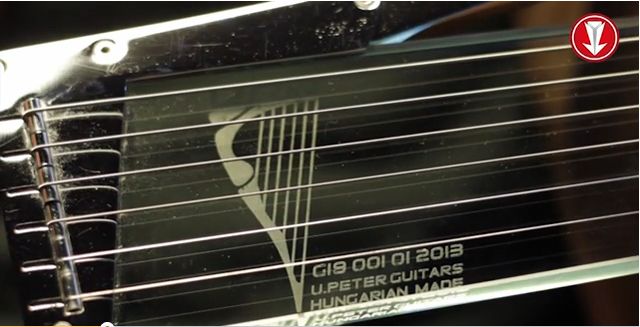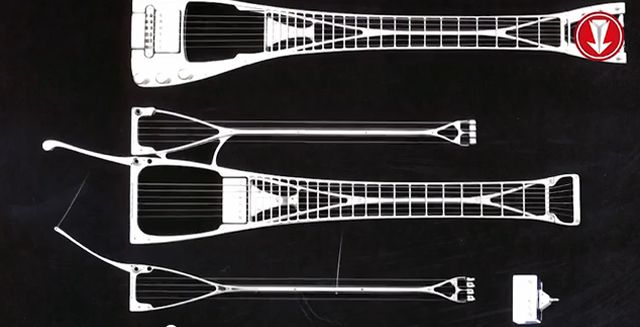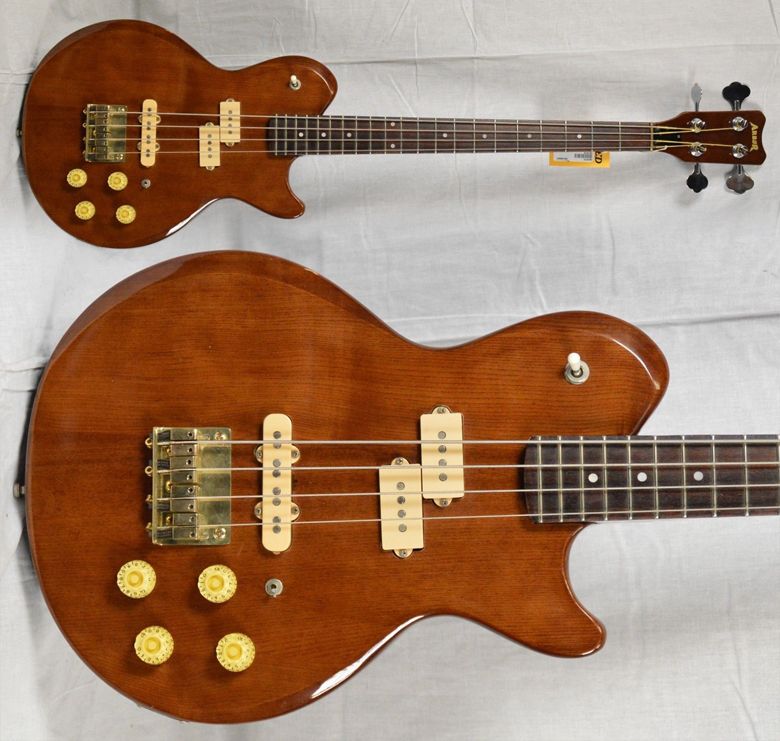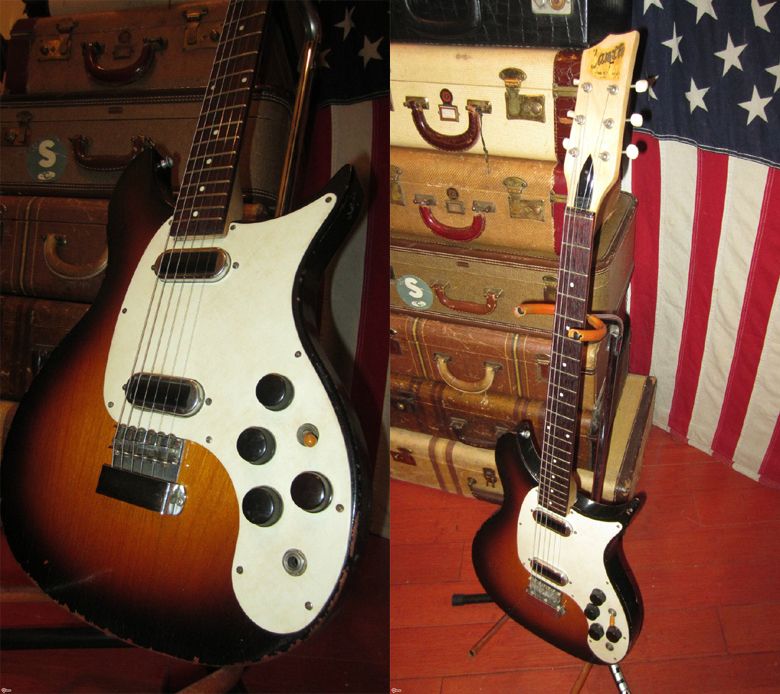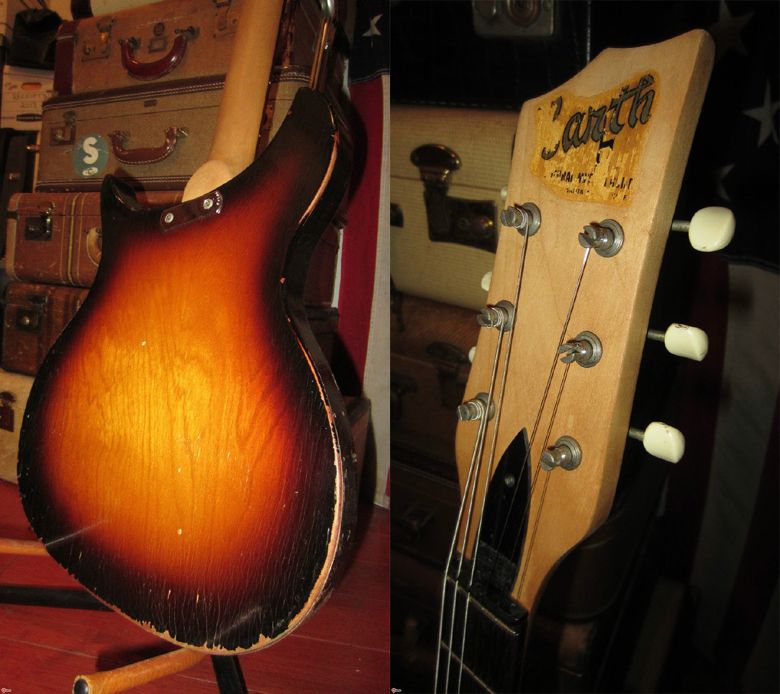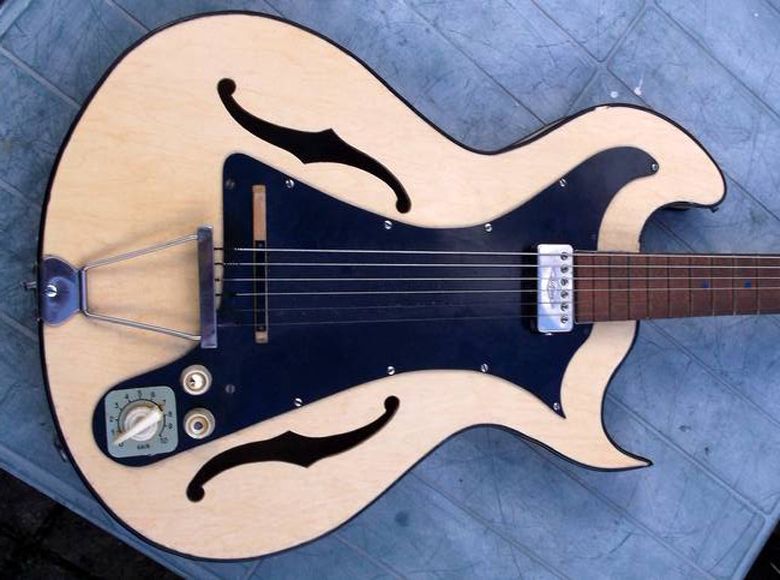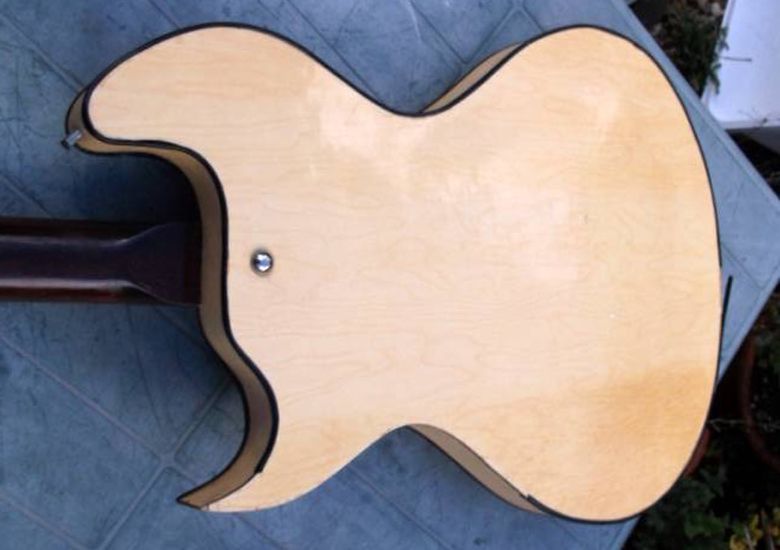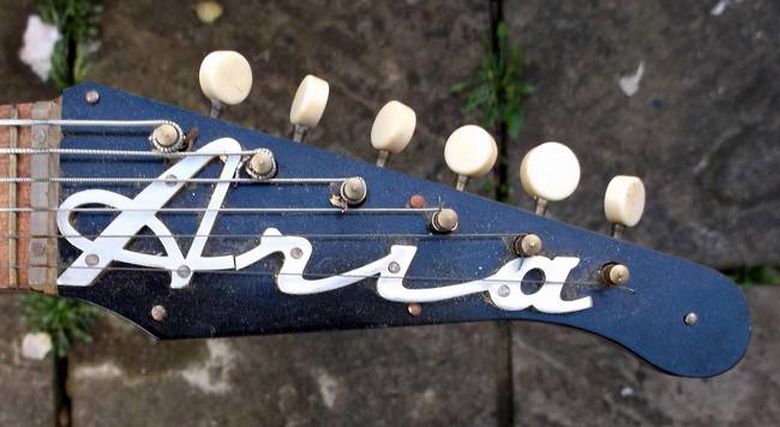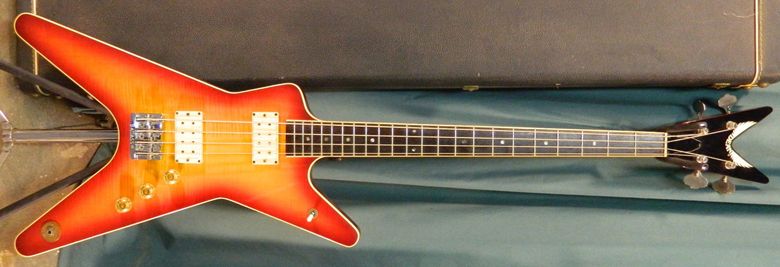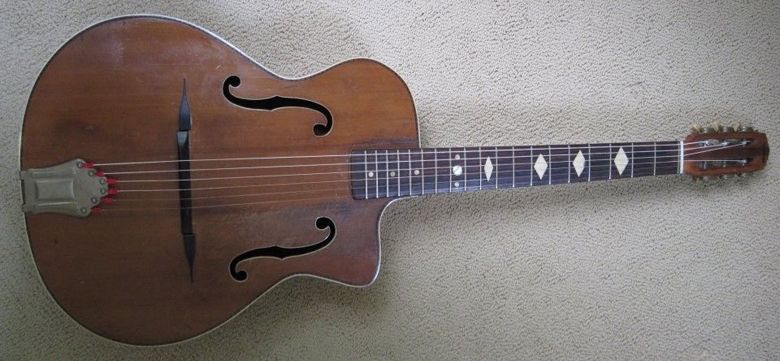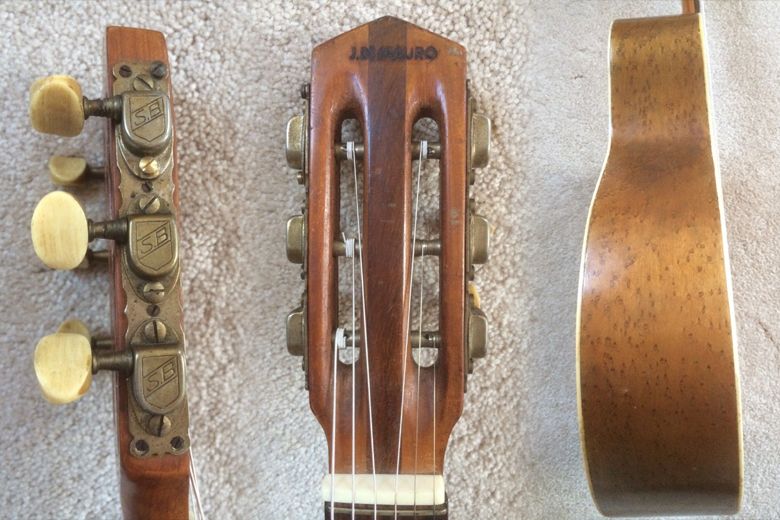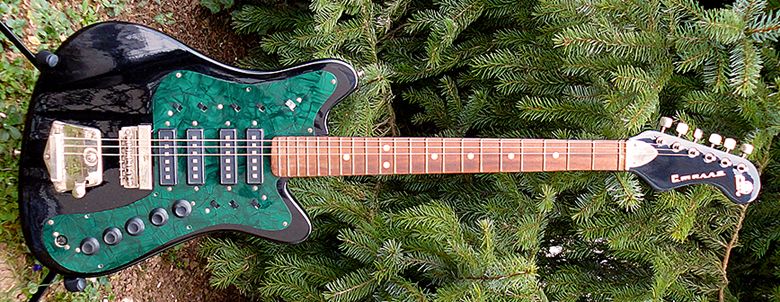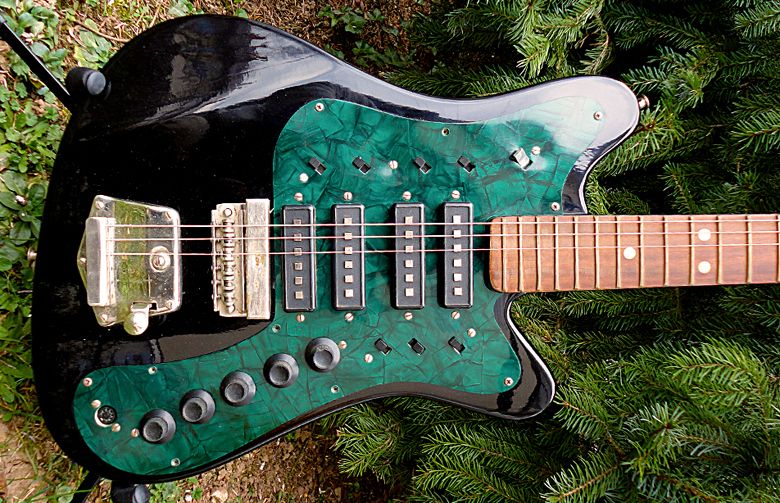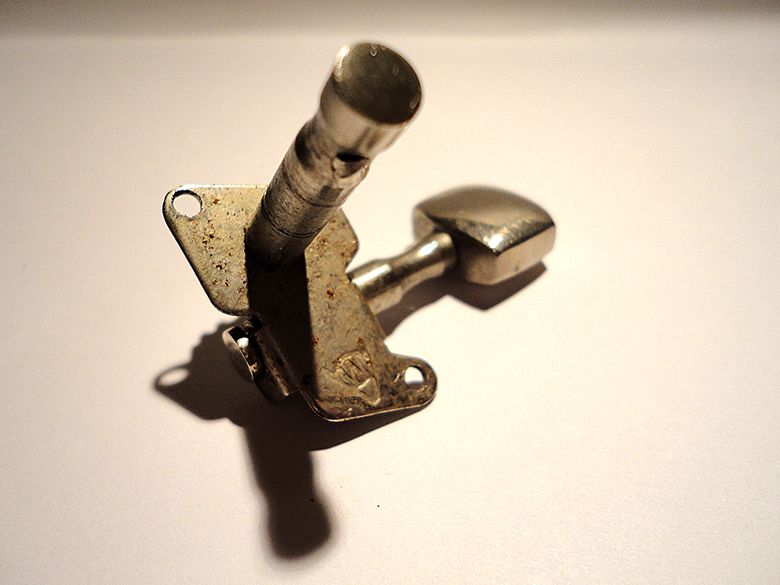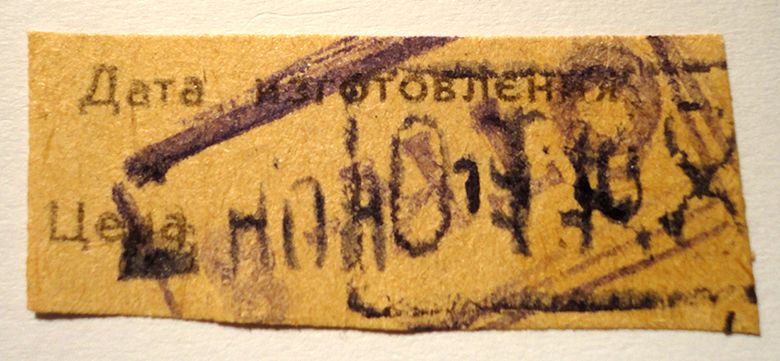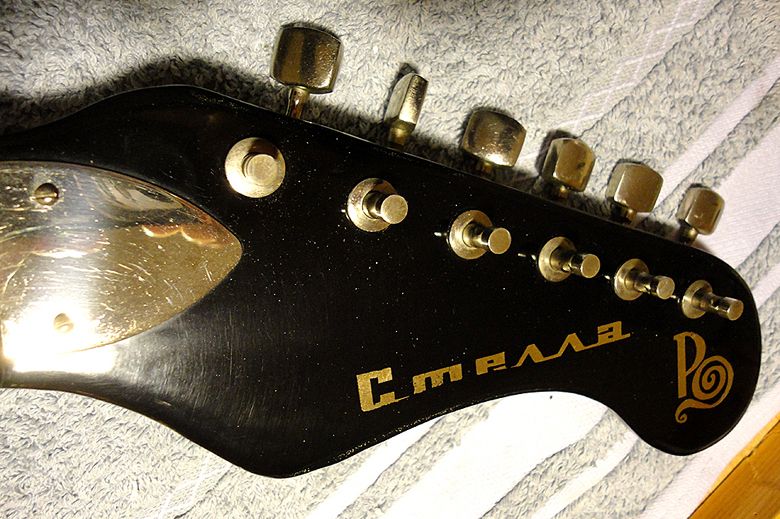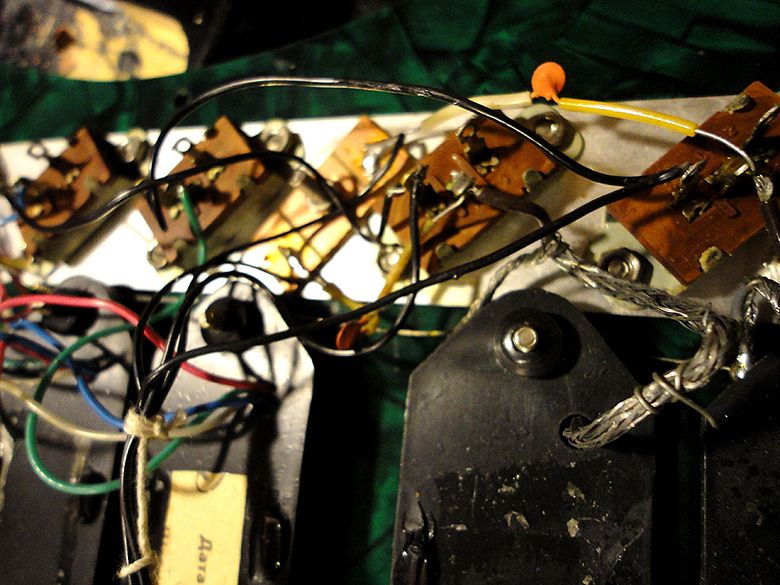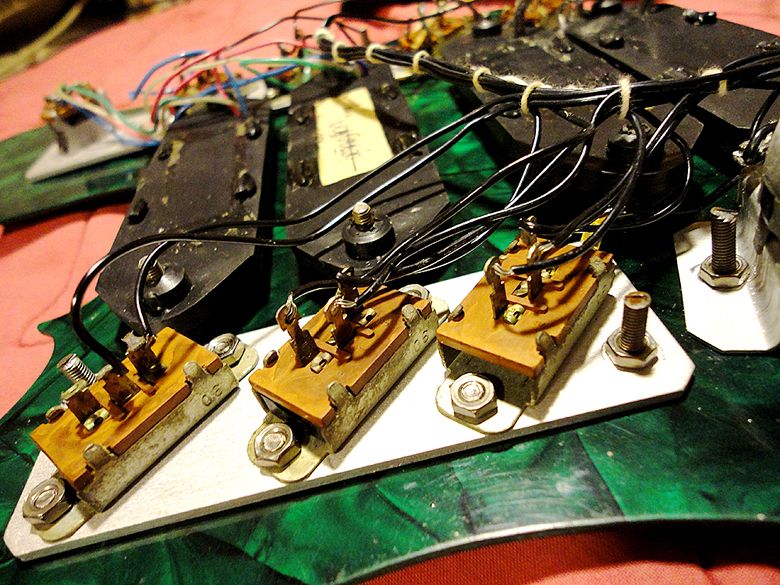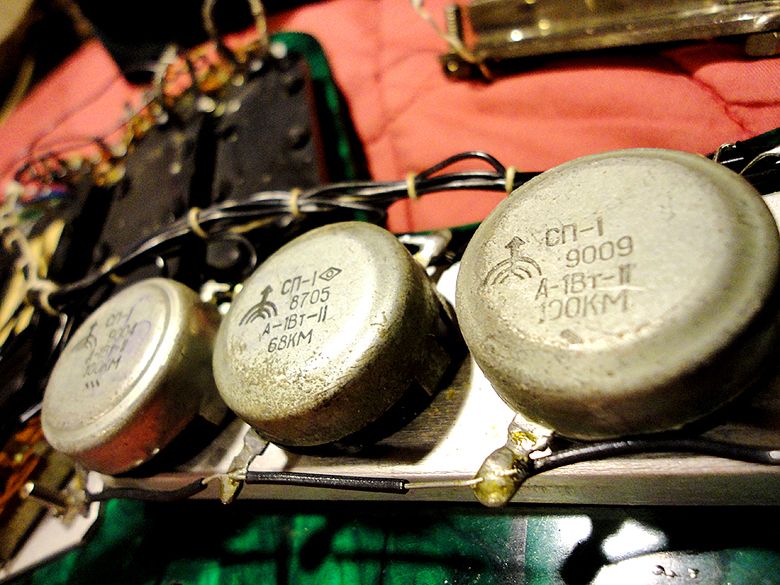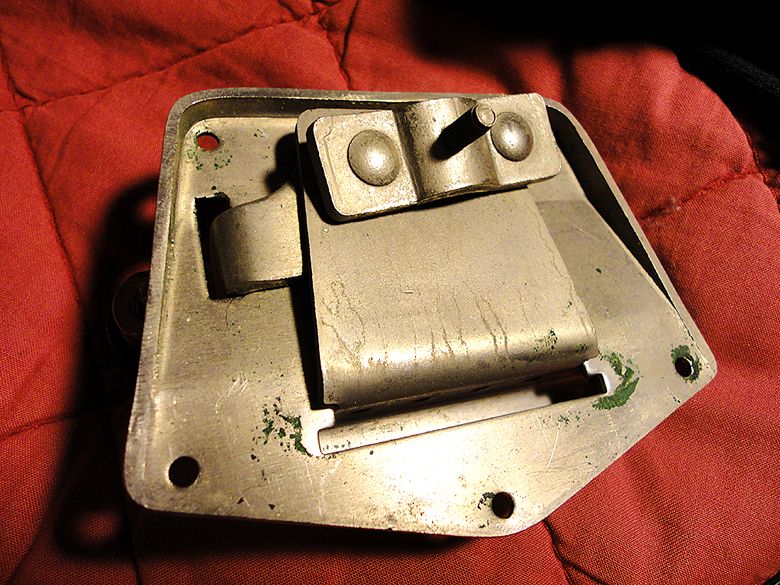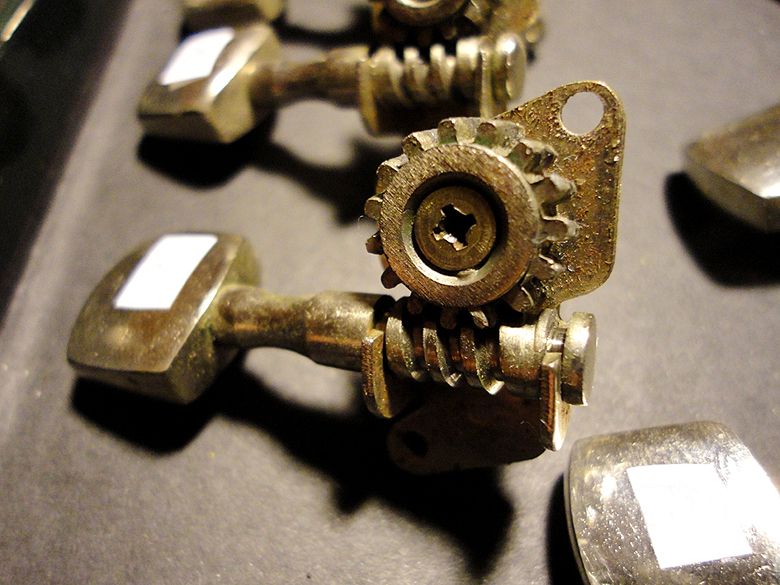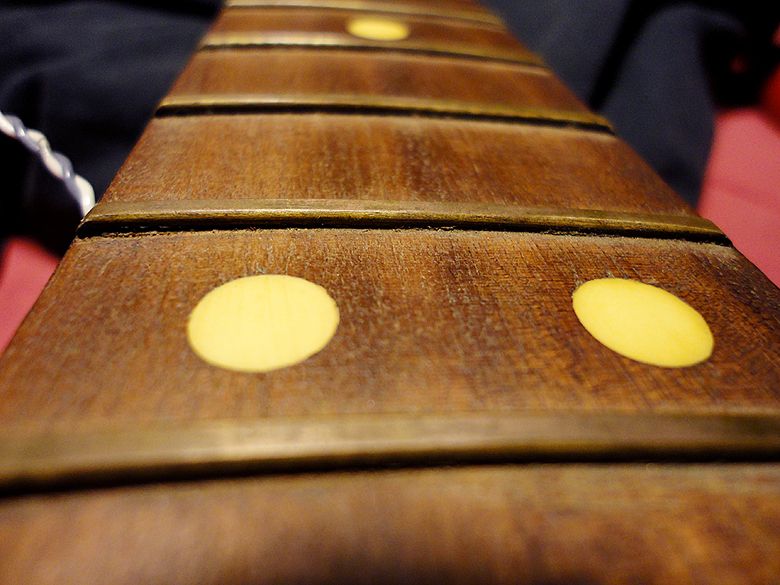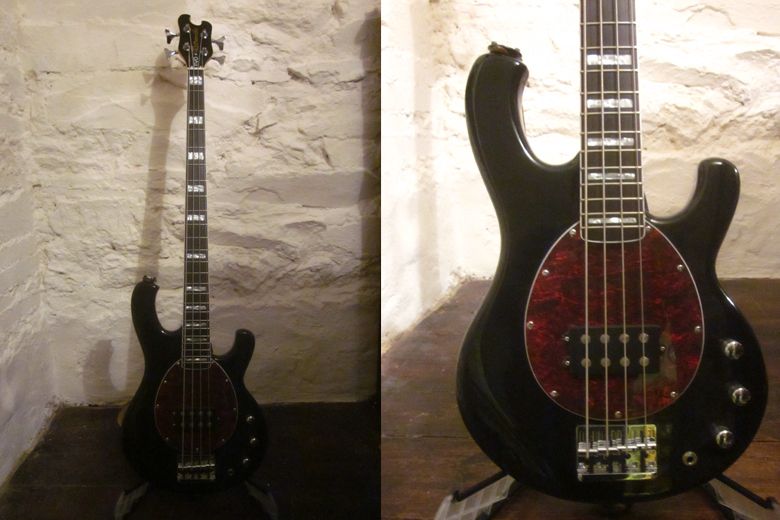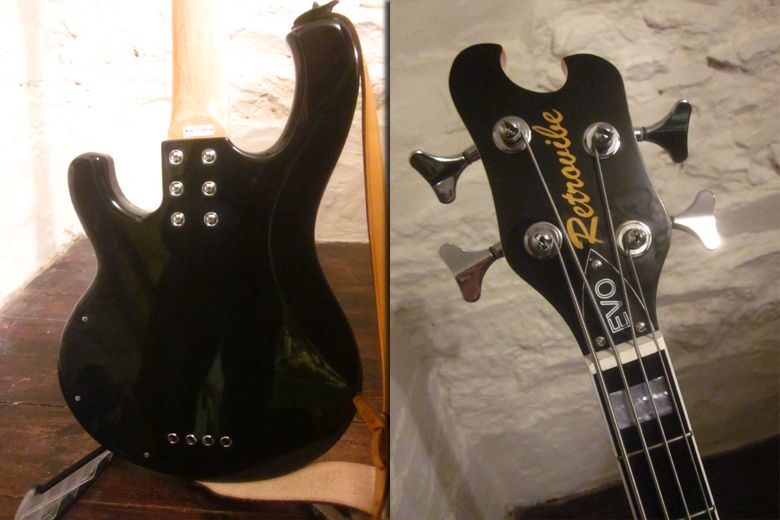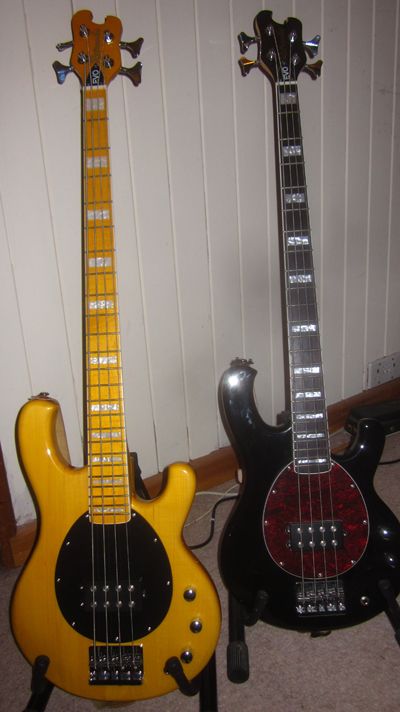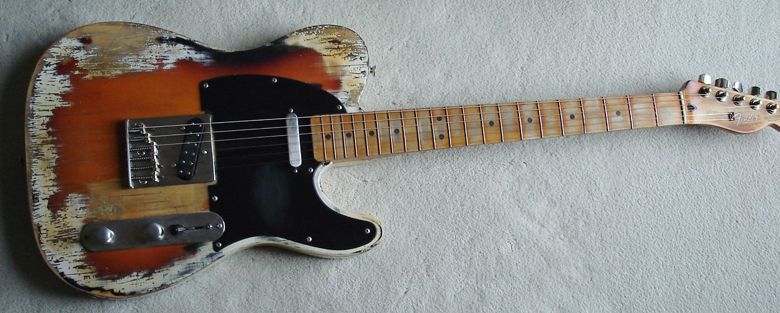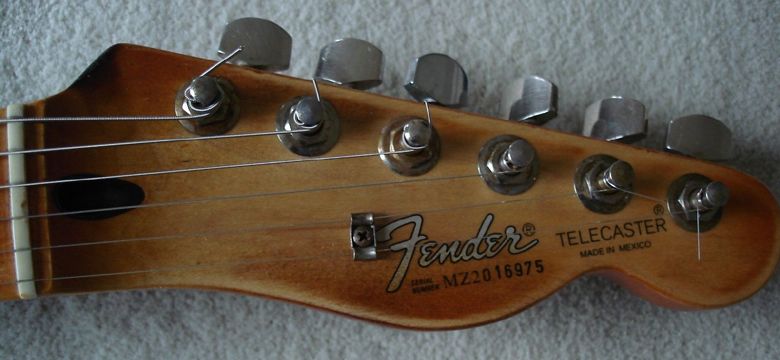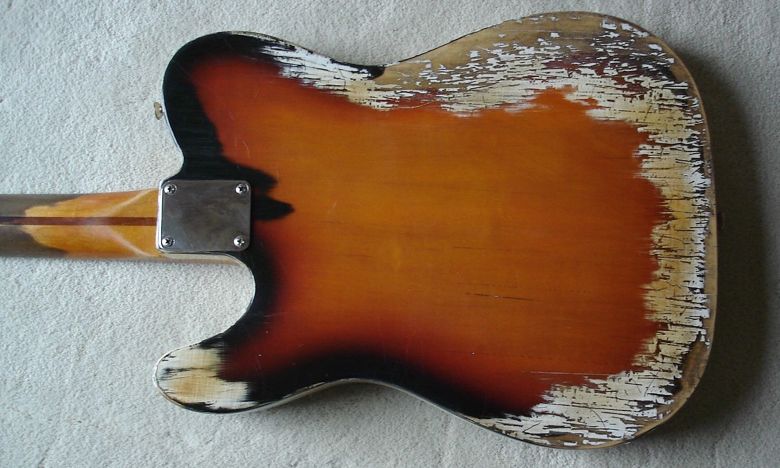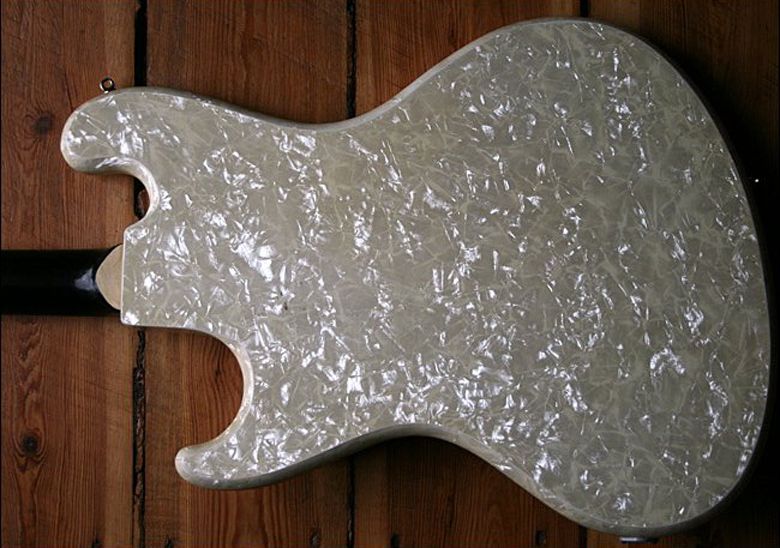guitarz.blogspot.com:
Never mind if you can't speak Hungarian, this video is still well worth checking out. I like that these steel and glass guitars push the boundaries of guitar design to its limits. The irony is, of course, that most of these sophisticated pieces of engineering are actually descendants of that most primitive type of guitar, namely those made from cigar boxes and other recycled parts and played with a slide.
Thanks to Guitarz reader Arpad for bringing these highly individual instruments to my attention.
G L Wilson
© 2014, Guitarz - The Original Guitar Blog - the blog that goes all the way to 11!
Please read our photo and content policy.
Monday, 31 March 2014
Sunday, 30 March 2014
1980s-era Arbor Bass
guitarz.blogspot.com:
The Arbor brandname is one which I am familiar with, but I know virtually nothing about them. This Arbor bass currently listed on eBay looks to be a solid enough well-built instrument and looking at it I'd guess it was 1980s Japanese judging by the build style, the brass hardware (check out that chunky bridge), and the use of DiMarzio (or possibly DiMarzio designed or just clone) pickups.
I tried scratching around on the net for more information, but there is not a lot to be had. Ask Jeeves tells us that:
The above-pictured Arbor bass is currently listed on eBay with a Buy It Now price of US $249.99.
G L Wilson
© 2014, Guitarz - The Original Guitar Blog - the blog that goes all the way to 11!
Please read our photo and content policy.
The Arbor brandname is one which I am familiar with, but I know virtually nothing about them. This Arbor bass currently listed on eBay looks to be a solid enough well-built instrument and looking at it I'd guess it was 1980s Japanese judging by the build style, the brass hardware (check out that chunky bridge), and the use of DiMarzio (or possibly DiMarzio designed or just clone) pickups.
I tried scratching around on the net for more information, but there is not a lot to be had. Ask Jeeves tells us that:
Arbor guitars came in both electric and acoustic and were first available on the market in 1983. An issue of the Vintage Guitar Price Guide says they are budget grade and that they carried bass guitars with a solid wood body. Arbor guitars were imported to the United States from China by Music Corp. (MTB), though no current information appears to be available online. Their company website was not working at the time of this writing.... which doesn't completely ring true to me. I'd have said they were Japanese, maybe even Korean, in origin. I did find the following on a forum to support this hypothesis:
Arbor guitars were founded in 1984 in Osaka, Japan by an ex-Ibanez president and an ex-Yamaha manager. A factory was purchased in Hamamatsu, Japan where guitars were produced from 1984-1986. They were forced to sell the company in the 3rd year of production due to lawsuits that were immediately filed by both Fender and Gibson, jointly. Production was moved to Korea by the new owners.I'm guessing that they also made guitars for Hohner, who marketed the Hohner Arbor series sometime in the late 1980s/90s.
The above-pictured Arbor bass is currently listed on eBay with a Buy It Now price of US $249.99.
G L Wilson
© 2014, Guitarz - The Original Guitar Blog - the blog that goes all the way to 11!
Please read our photo and content policy.
Saturday, 29 March 2014
1959 Barth Mark VIII sunburst electric guitar
guitarz.blogspot.com:
From one of America's forgotten guitar companies, this beauty is a Barth Mark VIII from 1959. Paul Barth was perhaps more famously a guitar designer for Rickenbacker which I think is quite apparent in the design here. He also designed guitars for Magnatone and Mosrite, not to mention the infamous Black Widow guitars and basses which appeared under his own Bartell brandname and also Hohner.
As this guitar is supposedly named the Mark VIII, I do wonder how many other models there were. I know that there was certainly a single pickup version of this guitar because we've looked at that on Guitarz before.
Currently listed on eBay with a Buy It Now price of $2,999 which I personally think is optimistic.
G L Wilson
© 2014, Guitarz - The Original Guitar Blog - the blog that goes all the way to 11!
Please read our photo and content policy.
From one of America's forgotten guitar companies, this beauty is a Barth Mark VIII from 1959. Paul Barth was perhaps more famously a guitar designer for Rickenbacker which I think is quite apparent in the design here. He also designed guitars for Magnatone and Mosrite, not to mention the infamous Black Widow guitars and basses which appeared under his own Bartell brandname and also Hohner.
As this guitar is supposedly named the Mark VIII, I do wonder how many other models there were. I know that there was certainly a single pickup version of this guitar because we've looked at that on Guitarz before.
Currently listed on eBay with a Buy It Now price of $2,999 which I personally think is optimistic.
G L Wilson
© 2014, Guitarz - The Original Guitar Blog - the blog that goes all the way to 11!
Please read our photo and content policy.
Thursday, 27 March 2014
Very unusual vintage semi... one-off or production model? Who knows?
guitarz.blogspot.com:
Here's a weird guitar that I am unable to identify. I couldn't tell you if it was an actual production model or if it has a homemade body and has been pieced together from parts from an archtop hollowbody electric (witness the Hofner pickup mounted to the top end of the fingerboard). This guitar was offered for sale on eBay UK, but the auction finished before we were able to post about it here. The seller told us the little he knew about it:
Thanks to David C for bringing this guitar to my attention.
More photos here.
G L Wilson
© 2014, Guitarz - The Original Guitar Blog - the blog that goes all the way to 11!
Please read our photo and content policy.
Here's a weird guitar that I am unable to identify. I couldn't tell you if it was an actual production model or if it has a homemade body and has been pieced together from parts from an archtop hollowbody electric (witness the Hofner pickup mounted to the top end of the fingerboard). This guitar was offered for sale on eBay UK, but the auction finished before we were able to post about it here. The seller told us the little he knew about it:
I've no idea what this guitar is. I bought it in France at a street market.My guess would be that it is European in origin, maybe East European, although it does look somewhere between an Egmond (from The Netherlands) and a Wandre (from Italy). If anyone could actually identify this guitar, we'd love to hear from you.
It has an Aria nameplate in metal, it needs attention to restore it to it's potential so it's sold as seen and sold as NOT Aria.
I've not tested it as it has a funny looking lead socket and the action is high. Some of the black plastic trim is loose / missing so please look at the photos...
Thanks to David C for bringing this guitar to my attention.
More photos here.
G L Wilson
© 2014, Guitarz - The Original Guitar Blog - the blog that goes all the way to 11!
Please read our photo and content policy.
Wednesday, 26 March 2014
Dean ML Bass - Vintage 1981 Made in USA
guitarz.blogspot.com:
The Dean ML design is a hybrid between Gibson's Explorer and Flying V models. I've never been too struck by the shape of it until I saw this original American-made Dean ML bass from 1981. I guess some designs work better on a bass than on a guitar (and vice versa). Note the ubiquitous (for the period) DiMarzio pickups. This is a bass that makes quite a statement; I wish I was rock'n'roll enough to be able to carry off something like this!
Currently listed on eBay with a Buy It Now price of US $1,349. (Note, headstock has been repaired).
G L Wilson
© 2014, Guitarz - The Original Guitar Blog - the blog that goes all the way to 11!
Please read our photo and content policy.
The Dean ML design is a hybrid between Gibson's Explorer and Flying V models. I've never been too struck by the shape of it until I saw this original American-made Dean ML bass from 1981. I guess some designs work better on a bass than on a guitar (and vice versa). Note the ubiquitous (for the period) DiMarzio pickups. This is a bass that makes quite a statement; I wish I was rock'n'roll enough to be able to carry off something like this!
Currently listed on eBay with a Buy It Now price of US $1,349. (Note, headstock has been repaired).
G L Wilson
© 2014, Guitarz - The Original Guitar Blog - the blog that goes all the way to 11!
Please read our photo and content policy.
Monday, 24 March 2014
Greco BR600 Brawler 1970s vintage Japanese-made electric guitar
guitarz.blogspot.com:
Here's a Greco BR600 Brawler, a late 1970s Japanese-made guitar that I am totally unfamiliar with. Made by FujuGen Gakki, it's quite possible this model was intended for the Japanese home market only. Unlike many other Japanese guitars of this era - certainly those that they exported to the West - it isn't a copy of any pre-existing guitar model, although to my eyes it does seem to have a Rickenbacker-like quality to the design. The body is made of ash with a top of white sycamore (great maple), the neck is maple with a rosewood fingerboard, and the guitar features a 24-fret neck, two single coil pickups and a top mounted vibrato.
Currently being auctioned on eBay with a starting price of US $799.99.
G L Wilson
© 2014, Guitarz - The Original Guitar Blog - the blog that goes all the way to 11!
Please read our photo and content policy.
Here's a Greco BR600 Brawler, a late 1970s Japanese-made guitar that I am totally unfamiliar with. Made by FujuGen Gakki, it's quite possible this model was intended for the Japanese home market only. Unlike many other Japanese guitars of this era - certainly those that they exported to the West - it isn't a copy of any pre-existing guitar model, although to my eyes it does seem to have a Rickenbacker-like quality to the design. The body is made of ash with a top of white sycamore (great maple), the neck is maple with a rosewood fingerboard, and the guitar features a 24-fret neck, two single coil pickups and a top mounted vibrato.
Currently being auctioned on eBay with a starting price of US $799.99.
G L Wilson
© 2014, Guitarz - The Original Guitar Blog - the blog that goes all the way to 11!
Please read our photo and content policy.
Sunday, 23 March 2014
1950s Di Mauro gypsy jazz guitar with f-holes
guitarz.blogspot.com:
Gypsy jazz guitar wasn't all about Selmer and Maccaferri. Here's a gorgeous 1950s gypsy jazz guitar with f-holes made by Joseph Di Mauro (the Elder). Check out that rich patina on the spruce top and birdseye maple sides. It's a very classy guitar with bags of period character. You can just imagine the life it might had led playing tunes late into the night in smokey French bars.
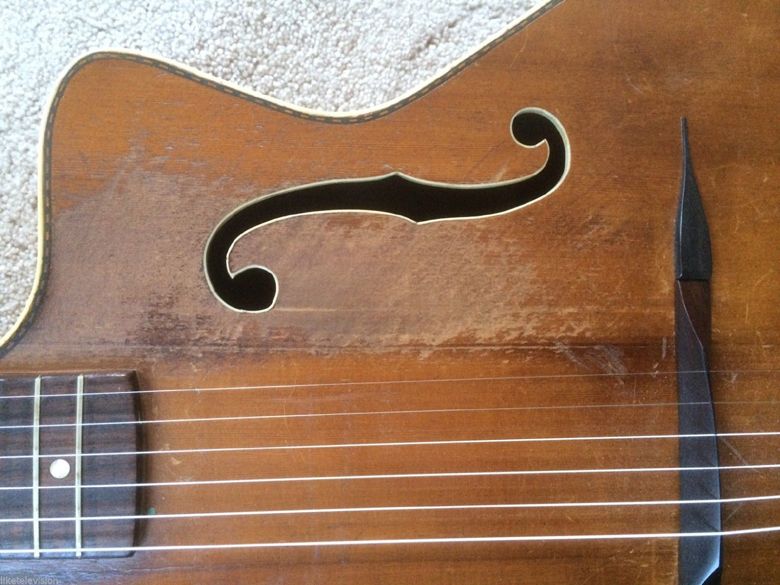
Currently listed on eBay with a Buy It Now price of US $5,499.
G L Wilson
© 2014, Guitarz - The Original Guitar Blog - the blog that goes all the way to 11!
Please read our photo and content policy.
Gypsy jazz guitar wasn't all about Selmer and Maccaferri. Here's a gorgeous 1950s gypsy jazz guitar with f-holes made by Joseph Di Mauro (the Elder). Check out that rich patina on the spruce top and birdseye maple sides. It's a very classy guitar with bags of period character. You can just imagine the life it might had led playing tunes late into the night in smokey French bars.

Currently listed on eBay with a Buy It Now price of US $5,499.
G L Wilson
© 2014, Guitarz - The Original Guitar Blog - the blog that goes all the way to 11!
Please read our photo and content policy.
Saturday, 22 March 2014
Your guitars: a Russian-made Stella guitar - inside and out
guitarz.blogspot.com:
Hi, Gavin,
I'm following Guitarz blog for quite some time and I have the guitar you already posted but I find it just too interesting not to send you more info and pics on it, in case you want to post it.
It's Russian Stella electric guitar, made in 1979. A friend of mine had it for years in his closet, looks almost brand new, and decided to give it to me. I opened it up and took bunch of pictures - it's quite a crazy guitar.
Its made in Rostov Na Donu in the USSR in 1979 then put together in 1980 - at least judging from labels I found inside on piece of deteriorating paper. It cost 210 Rubelj, and it says so on plate on back of the guitar :) Finish is the weirdest thing I've seen (but not weirdest part of the guitar) - you need a bloody axe to chip it, it's just impervious. Thus, the wood remains a mystery. Neck is stable but the frets...made of brass and pretty much rectangular.
© 2014, Guitarz - The Original Guitar Blog - the blog that goes all the way to 11!
Please read our photo and content policy.
Hi, Gavin,
I'm following Guitarz blog for quite some time and I have the guitar you already posted but I find it just too interesting not to send you more info and pics on it, in case you want to post it.
It's Russian Stella electric guitar, made in 1979. A friend of mine had it for years in his closet, looks almost brand new, and decided to give it to me. I opened it up and took bunch of pictures - it's quite a crazy guitar.
Its made in Rostov Na Donu in the USSR in 1979 then put together in 1980 - at least judging from labels I found inside on piece of deteriorating paper. It cost 210 Rubelj, and it says so on plate on back of the guitar :) Finish is the weirdest thing I've seen (but not weirdest part of the guitar) - you need a bloody axe to chip it, it's just impervious. Thus, the wood remains a mystery. Neck is stable but the frets...made of brass and pretty much rectangular.
What's weirdest are
the electronics - seems they took guts from old TVs or radios and
accommodate them for guitar - looks like a jungle in there - mind you,
they are done VERY neatly, check the photos - little knots that hold
wires together etc. And of course, the goodies: stereo output, phase
outs and all other mysterious switches and pots.
Sound
is actually very good if you manage to find right combination of switch
positions and volume pots - which is, due to possible combinations,
almost random - you flick first one up and third one down, open this and
that volume and you get awesome tone, then you flick something else and
it sounds like mosquito. And electronics are quiet, specially
considering how much is going on. I got myself made a Y-cable with 5-din
input on one end and two 1/4" input-jacks to which I plug the normal
guitar cables - this way I get stereo output and can also hook up two
amps.
Check this great video I found on youtube out, it explains much: https://www.youtube.com/watch?v=1SyALQncxY4
Vibrato
bar is sadly missing, but seems it's there for the looks only - it does
nothing. The metal thing just above the bridge is string dampener (foam
is missing) which is lifted by pulling it up and it is retained there by
springs underneath it.
Tuners are horrible, you can wiggle them left and right, bridge is quite the same. But overall, the shape is one of most pleasant shapes I've ever hold, neck is chunky just enough, the emerald green pickguard is great.
Tuners are horrible, you can wiggle them left and right, bridge is quite the same. But overall, the shape is one of most pleasant shapes I've ever hold, neck is chunky just enough, the emerald green pickguard is great.
Once I will deal with frets, tuners and bridge, and maybe shield electronics, it will be one spiffy guitar.
Thanks for reading,
Barth
© 2014, Guitarz - The Original Guitar Blog - the blog that goes all the way to 11!
Please read our photo and content policy.
Thursday, 20 March 2014
Bass guitar review: The ProBass Retrovibe EVO bass
guitarz.blogspot.com:
ProBass Retrovibe basses are the brainchild of David Konig who gets the basses built in China to his exacting specifications and then sells them to UK and European customers via his website. With no middlemen involved and no distributors or stockists other than Konig himself, he is able to keep these basses extremely competitively priced. In fact, the whole current range consists of basses costing between £249 and £319 plus post and packaging fees.
Retrovibe's debut model was the RV4 (and RV5 five-string model) strongly influenced by Rickenbacker's 4000 series bass guitars and equipped with two MusicMan style humbuckers. At the request of RIC, that particular model has now been discontinued. Its replacement was the Retrovibe Vantage which I can best describe as looking as if it's the offspring of an intimate liasion between a Rickenbacker 4003 and a Fender Jazz Bass. More recently Retrovibe have followed this up with the Zygote which appears to be a more evolved version of the Vantage, and the EVO, which is the bass we are looking at here.
But before I go on, let me backtrack and set the scene a little. I was recently offered some bass playing gigs with a local psychedelically-inclined band called Sendelica, to stand-in for their usual bassist on certain gigs that he's not able to play. Some of you may well have heard of them, being very well known on the psyche, "space rock" and progressive scene and having had recorded with specialist vinyl-only record label Fruits De Mer (which itself has something of a cult following). I didn't hesitate too long before accepting this offer, even though I didn't really have a bass suitable for the gig. I started practising using my Fender Pawn Shop Bass VI but pretty soon decided that for Sendelica's songs I wanted to use a Drop D tuning, and on a short-scale instrument like the Bass VI where the low E string can often be a bit flabby, tuning down to D wasn't going to be an option.
I decided I needed a regular long-scale, 4-string bass, and so spent days scouring the internet for suitable candidates that I thought would be within my budget. I didn't want to go the P-Bass or J-Bass route, not being a particular fan of either of those. I toyed with the idea of a Thunderbird style design, maybe an Epiphone or an ESP, but then I found many reviews criticising such basses as being extremely neck heavy.
Then something clicked in the back of my mind and I remembered Retrovibe basses, having previously seen the website a year or two ago. I checked the website and liked what I saw of the EVO model. I shot off a quick email to David Konig to enquire about how well the bass handled Drop-D tuning, and he very quickly replied, having tried it out on his own EVO, that it indeed handled the tuning very nicely. I then ordered a bass straight away and it was delivered just two days later.
So, enough of my life story for the time being... What's the EVO like? The website tells us that it "draws on many different styles, old and new, to deliver a robust and eye-catching design which sounds as good as it looks", and in the case of the EVO those different styles include Musicman Stingray, Rickenbacker, Fender Jazz Bass, and Warwick. To clarify, it does look a bit like a Musicman Stingray (especially with that ovoid pickguard) but has a more compact body, the horns of which have a touch of Rickenbacker about them; the 24-fret neck is beautifully bound, has pearloid block markers, and tapers to a narrow Jazz Bass-like 38mm at the nut; the headstock reminds me of those of Warwick basses, but with a little cut-out which makes it almost Rickenbacker-like. It does look to be a really classy instrument.
The body is basswood (as you'd probably expect), the neck is maple and beautifully finished (none of this "satin feel" crap, i.e. unfinished necks you find on so many cheaper guitars) and it has a rosewood fingerboard (plus white binding and block markers as already mentioned). It's a bolt-on neck, attached to the body by no less that six bolts - that neck ain't going to move!
The hardware - bridge, tuners, control knobs - are all very substantial and on this example are finished in chrome. Pickup-wise we have one MM-style humbucker although you may have noticed in the photos there are three controls. This set-up is more versatile than you may think, with two volume controls - one for each coil of the MM-style pickup - and a single tone control. It essentially functions as a two pickup instrument and despite the proximity of the two coils there are a wide range of tones to be dialled in.
I was practising with this bass every day for a month solid (I had a lot of material to learn!), and have since gigged with it and recorded with it. I found that the EVO hangs well upon a strap so that the neck is positioned just where I want it. The neck is a joy to play. As someone more familiar with guitar string spacing, the narrow spacing up at the nut suits me fine, and the large block markers are invaluable for helping me navigate around the fingerboard. The EVO certainly delivers sound-wise; I found it sat very nicely in the live mix along with lead guitar, saxophone, drums, and various samples all doing their thing. The tuning is stable and the bass happily handles my Drop D tuning with no sign of flabbiness on the lower string.
The build quality and finish are excellent. I actually showed my EVO to a luthier whilst I was picking up another guitar he'd been working on. He seemed quite impressed with the quality; he did comment that the action could be even lower but I personally wouldn't want it any lower, it suits me fine as it currently is. If I did have to nitpick, I'd mention that there are a few sharp-ish fret ends that could benefit from a fret dress, however thankfully these are on the bass side rather than the treble side of the fingerboard and so my fingers rarely encounter them. That, and the "EVO" text on the trussrod cover is slightly askew... but THAT really is splitting hairs!
Those minor points aside if there was one slight niggle that I personally have about the EVO it would be that, as someone who is - shall we say - well-built, I sometimes wonder if the compact body shape might make the bass too small for me. But then I remind myself that it DOES hang very nicely on a strap, presenting itself in the perfect playing position. (And remember of course there are much smaller-bodied instruments played by bassists of all shapes and sizes, for instance minimalist Steinbergers and that whole kind of thing.) Another positive is that the EVO would suit players of a smaller stature, younger players, female players, etc. Weight, by the way, is approximately 3.5kg / 7.4lbs.
As you may have gathered I am quite a fan of this bass. I really think I made the right choice. In fact, I am seriously considering buying a second example to keep in regular tuning and as a back-up bass at gigs. (Actually I'd love a fretless EVO if that was ever to become an option).
Retrovibe basses are produced in a number of different finishes, with each being strictly a limited edition. Of the five finishes available on the EVO, there were only eight examples of each produced. Maybe, if the range is successful, there might be further production.
Priced at £249 / £279 / £289 depending on finish options.
Available online only from probass.co.uk
ADDITIONAL (3 April 2014): Just to show that I put my money where my mouth is, I did indeed buy a second Retrovibe EVO (see photo opposite). That's a Transparent Amber finish. Very nice indeed!
G L Wilson
© 2014, Guitarz - The Original Guitar Blog - the blog that goes all the way to 11!
Please read our photo and content policy.
ProBass Retrovibe basses are the brainchild of David Konig who gets the basses built in China to his exacting specifications and then sells them to UK and European customers via his website. With no middlemen involved and no distributors or stockists other than Konig himself, he is able to keep these basses extremely competitively priced. In fact, the whole current range consists of basses costing between £249 and £319 plus post and packaging fees.
Retrovibe's debut model was the RV4 (and RV5 five-string model) strongly influenced by Rickenbacker's 4000 series bass guitars and equipped with two MusicMan style humbuckers. At the request of RIC, that particular model has now been discontinued. Its replacement was the Retrovibe Vantage which I can best describe as looking as if it's the offspring of an intimate liasion between a Rickenbacker 4003 and a Fender Jazz Bass. More recently Retrovibe have followed this up with the Zygote which appears to be a more evolved version of the Vantage, and the EVO, which is the bass we are looking at here.
But before I go on, let me backtrack and set the scene a little. I was recently offered some bass playing gigs with a local psychedelically-inclined band called Sendelica, to stand-in for their usual bassist on certain gigs that he's not able to play. Some of you may well have heard of them, being very well known on the psyche, "space rock" and progressive scene and having had recorded with specialist vinyl-only record label Fruits De Mer (which itself has something of a cult following). I didn't hesitate too long before accepting this offer, even though I didn't really have a bass suitable for the gig. I started practising using my Fender Pawn Shop Bass VI but pretty soon decided that for Sendelica's songs I wanted to use a Drop D tuning, and on a short-scale instrument like the Bass VI where the low E string can often be a bit flabby, tuning down to D wasn't going to be an option.
I decided I needed a regular long-scale, 4-string bass, and so spent days scouring the internet for suitable candidates that I thought would be within my budget. I didn't want to go the P-Bass or J-Bass route, not being a particular fan of either of those. I toyed with the idea of a Thunderbird style design, maybe an Epiphone or an ESP, but then I found many reviews criticising such basses as being extremely neck heavy.
 |
| Sendelica live at the Zephyr Lounge, Leamington Spa, 7 March 2014. Me on the right on the Retrovibe EVO bass. Photo: Matty Dread |
So, enough of my life story for the time being... What's the EVO like? The website tells us that it "draws on many different styles, old and new, to deliver a robust and eye-catching design which sounds as good as it looks", and in the case of the EVO those different styles include Musicman Stingray, Rickenbacker, Fender Jazz Bass, and Warwick. To clarify, it does look a bit like a Musicman Stingray (especially with that ovoid pickguard) but has a more compact body, the horns of which have a touch of Rickenbacker about them; the 24-fret neck is beautifully bound, has pearloid block markers, and tapers to a narrow Jazz Bass-like 38mm at the nut; the headstock reminds me of those of Warwick basses, but with a little cut-out which makes it almost Rickenbacker-like. It does look to be a really classy instrument.
The body is basswood (as you'd probably expect), the neck is maple and beautifully finished (none of this "satin feel" crap, i.e. unfinished necks you find on so many cheaper guitars) and it has a rosewood fingerboard (plus white binding and block markers as already mentioned). It's a bolt-on neck, attached to the body by no less that six bolts - that neck ain't going to move!
The hardware - bridge, tuners, control knobs - are all very substantial and on this example are finished in chrome. Pickup-wise we have one MM-style humbucker although you may have noticed in the photos there are three controls. This set-up is more versatile than you may think, with two volume controls - one for each coil of the MM-style pickup - and a single tone control. It essentially functions as a two pickup instrument and despite the proximity of the two coils there are a wide range of tones to be dialled in.
I was practising with this bass every day for a month solid (I had a lot of material to learn!), and have since gigged with it and recorded with it. I found that the EVO hangs well upon a strap so that the neck is positioned just where I want it. The neck is a joy to play. As someone more familiar with guitar string spacing, the narrow spacing up at the nut suits me fine, and the large block markers are invaluable for helping me navigate around the fingerboard. The EVO certainly delivers sound-wise; I found it sat very nicely in the live mix along with lead guitar, saxophone, drums, and various samples all doing their thing. The tuning is stable and the bass happily handles my Drop D tuning with no sign of flabbiness on the lower string.
The build quality and finish are excellent. I actually showed my EVO to a luthier whilst I was picking up another guitar he'd been working on. He seemed quite impressed with the quality; he did comment that the action could be even lower but I personally wouldn't want it any lower, it suits me fine as it currently is. If I did have to nitpick, I'd mention that there are a few sharp-ish fret ends that could benefit from a fret dress, however thankfully these are on the bass side rather than the treble side of the fingerboard and so my fingers rarely encounter them. That, and the "EVO" text on the trussrod cover is slightly askew... but THAT really is splitting hairs!
Those minor points aside if there was one slight niggle that I personally have about the EVO it would be that, as someone who is - shall we say - well-built, I sometimes wonder if the compact body shape might make the bass too small for me. But then I remind myself that it DOES hang very nicely on a strap, presenting itself in the perfect playing position. (And remember of course there are much smaller-bodied instruments played by bassists of all shapes and sizes, for instance minimalist Steinbergers and that whole kind of thing.) Another positive is that the EVO would suit players of a smaller stature, younger players, female players, etc. Weight, by the way, is approximately 3.5kg / 7.4lbs.
As you may have gathered I am quite a fan of this bass. I really think I made the right choice. In fact, I am seriously considering buying a second example to keep in regular tuning and as a back-up bass at gigs. (Actually I'd love a fretless EVO if that was ever to become an option).
Retrovibe basses are produced in a number of different finishes, with each being strictly a limited edition. Of the five finishes available on the EVO, there were only eight examples of each produced. Maybe, if the range is successful, there might be further production.
Priced at £249 / £279 / £289 depending on finish options.
Available online only from probass.co.uk
ADDITIONAL (3 April 2014): Just to show that I put my money where my mouth is, I did indeed buy a second Retrovibe EVO (see photo opposite). That's a Transparent Amber finish. Very nice indeed!
G L Wilson
© 2014, Guitarz - The Original Guitar Blog - the blog that goes all the way to 11!
Please read our photo and content policy.
Tuesday, 18 March 2014
Mexican-made Fender Telecaster with supposedly professional relic finish
guitarz.blogspot.com:
I was thinking of highlighting this once poor unsuspecting Mexican-made Fender Telecaster as another in our very occasional "When Relics Go Bad" series. But I have to ask, "Is it just me?" I personally think that it looks catastrophically bad. Apparently it was a professional relic job but I couldn't care less how much work went into making it look like this, to my eyes it appears to be a painfully inept piece of work. I just look at it and think, "How would a guitar sustain a distressed finish like this through natural usage? One of the first places you'd expect to see wear and tear would be in the middle of the rear of the body, an area prone to the infamous "belt buckle rash". However on this guitar that particular part of the finish is almost pristine.
You know what? I look at a creation like this and I just don't know what to think any more.
Currently listed on eBay with a Buy It Now price of US $999. And what's more, someone will probably buy it.
G L Wilson
© 2014, Guitarz - The Original Guitar Blog - the blog that goes all the way to 11!
Please read our photo and content policy.
I was thinking of highlighting this once poor unsuspecting Mexican-made Fender Telecaster as another in our very occasional "When Relics Go Bad" series. But I have to ask, "Is it just me?" I personally think that it looks catastrophically bad. Apparently it was a professional relic job but I couldn't care less how much work went into making it look like this, to my eyes it appears to be a painfully inept piece of work. I just look at it and think, "How would a guitar sustain a distressed finish like this through natural usage? One of the first places you'd expect to see wear and tear would be in the middle of the rear of the body, an area prone to the infamous "belt buckle rash". However on this guitar that particular part of the finish is almost pristine.
You know what? I look at a creation like this and I just don't know what to think any more.
Currently listed on eBay with a Buy It Now price of US $999. And what's more, someone will probably buy it.
G L Wilson
© 2014, Guitarz - The Original Guitar Blog - the blog that goes all the way to 11!
Please read our photo and content policy.
Sunday, 16 March 2014
Vintage German-made pearloid-finished Migma solidbody electric guitar
guitarz.blogspot.com:
Most regular readers probably already know how much we like vintage German guitars here on Guitarz. This Migma solidbody was made in the former East Germany; the seller claims it is from the 1950s, but I think 1960s is far more likely, especially considering the pearlescent celluloid finish. Surprisingly, the guitar appears to have a set neck rather than a bolt-on, and in fact other than the headstock shape the whole neck looks as if it could easily have come off an archtop acoustic guitar - note how the neck joins the body at around the 14th fret, also the block markers and the very top end of the fingerboard without frets. The guitar's heritage is all very clear.
Note also the unusual attachments for clipping on a guitar strap.
Currently listed on eBay with a Buy It Now price of €649.
G L Wilson
© 2014, Guitarz - The Original Guitar Blog - the blog that goes all the way to 11!
Please read our photo and content policy.
Most regular readers probably already know how much we like vintage German guitars here on Guitarz. This Migma solidbody was made in the former East Germany; the seller claims it is from the 1950s, but I think 1960s is far more likely, especially considering the pearlescent celluloid finish. Surprisingly, the guitar appears to have a set neck rather than a bolt-on, and in fact other than the headstock shape the whole neck looks as if it could easily have come off an archtop acoustic guitar - note how the neck joins the body at around the 14th fret, also the block markers and the very top end of the fingerboard without frets. The guitar's heritage is all very clear.
Note also the unusual attachments for clipping on a guitar strap.
Currently listed on eBay with a Buy It Now price of €649.
G L Wilson
© 2014, Guitarz - The Original Guitar Blog - the blog that goes all the way to 11!
Please read our photo and content policy.
Subscribe to:
Comments (Atom)

